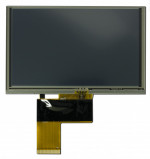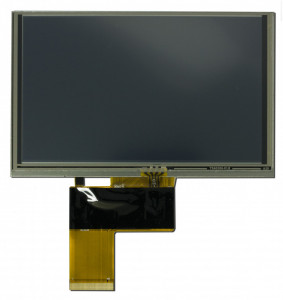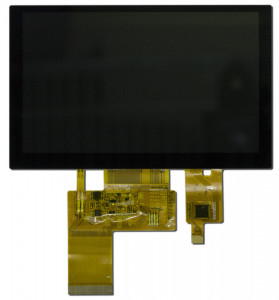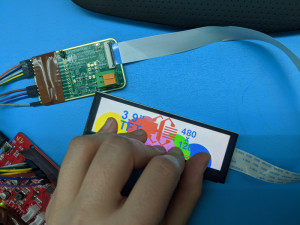
Resistive Touch vs. Capacitive Touch
When deciding between resistive and capacitive touch, be sure to consider where as well as how the display will be used. Different use cases call for different touch technology.
How does resistive touch work?
Resistive touchscreens use a relatively simple technology. A resistive touchscreen comprises two flexible sheets with an air gap between them. When the screen is touched, the sheets make contact. Then the touch location is calculated based on voltages using and an ADC. Read more about how to implement a resistive touchscreen.
Resistive touchscreens register touches made with a finger (even if gloved), stylus, pencil eraser or anything with an end blunt enough not to damage the screen. Most ATMs, card readers at the grocery store, and older home electronics (think that GPS you bought for your car in 2006) use resistive touch sensing.

Because resistive touchscreens are relatively simple and require only four lines to sense touch, the lines connecting the touchscreen to the microcontroller are often incorporated into the main display tail, meaning only one connection between the display module and the controller are needed.
How does capacitive touch work?
Capacitive touchscreens are a little more complicated. Capacitive touchscreens work by registering a change in an electrostatic field on the screen when touched with an adequately capacitive object, like a finger. Gloved fingers or a stylus may be used, but they must have conductive materials to simulate a bare finger.
As capacitive touchscreens require a controller and more lines, the tail of a capacitive touchscreen is usually separate from the main display tail.

Pros and Cons of Resistive Touch vs. Capacitive Touch
Beyond the methods of obtaining a touch, there are pros and cons that must be considered when deciding between a resistive touchscreen and a capacitive touchscreen.
The following table compares resistive and capacitive touchscreens across a variety of categories. In short, resistive touchscreens are less expensive and work well in outdoor applications, but do not age well (they can get scratched, and become hazy with age) and can only register a single touch. Capacitive touchscreens use a glass top layer so they maintain more of the display’s brightness. Plus, capacitive touchscreens can support multiple touches and gestures. The main draw backs for capacitive touchscreens are the higher cost and lower tolerance of environmental factors.
Resistive vs Capacitive Touch Pros and Cons
| Resistive Touch | Capacitive Touch | |
|---|---|---|
| Cost | Low. Uses simple circuits and interfacing. | Higher. Requires a processor for interfacing. |
| Impact Resistance | High. The screen can be scratched, but is more impact durable. However, if the screen is cracked, the touch will no longer function. | Low. An impact can crack the screen. However, the touch will still function with a cracked screen. |
| Contaminant Resistance | High. Dirt and moisture droplets do not affect the touch sensing. | Low. Dirt and moisture interfere with touch sensing, resulting in registering unintended touches. |
| Light Transmission | Poor. A new touchscreen cuts light transmission from the display by about 20%. As the touchscreen ages, it can yellow or become hazy, further limiting light transmission. | Good. A cap touchscreen cuts light transmission by approximately 10%, or less. Age does not affect the light transmission. |
| Long Term Durability | Poor. The flexible material will yellow with ages and is prone to scratches. This will affect readability of the display. | Good. The outer surface of the touchscreen is fairly scratch resistant, offering protection to the display. |
| Touch Sensing | Single touch. Some pressure is required to register the touch. | Multiple touches detectable. Gestures like swipes and pinches can be supported. |
| Other Considerations | Requires calibration. | Higher power consumption. |
| Best Uses | * Large screens *Simple touches *Cost constrained applications *Outdoor applications where environmental conditions are a factor *Applications where wet or gloved hands will be used | *Small screens where accuracy is critical *Applications requiring multiple touches or gestures *Applications requiring high contrast and brightness *Applications where long-term durability is critical |
Compare Display Families
Compare some of our families of displays that include a no-touch, resistive touch, and cap touch version. The 5″ sunlight readable displays, above, start at 1000 nits and drop into the 800s.
Further, consider our 3.9″ bar-type display. Without a touchscreen, this display boasts a respectable brightness of 500 nits. With a capacitive touchscreen applied, the brightness drops to a typical brightness of 400 nits. The brightness with a resistive touchscreen applied drops even further, to a typical brightness of 350 nits.

Further Reading
https://ca.pipglobal.com/archive/literature/PIP-WP-Gloves-and-Touchscreen-Compatibility.pdf
Contact Us
If you have any questions, we can be reached at support@crystalfontz.com, we also provide chat and telephone support Monday through Friday during our open hours.
We love to hear about your projects! Find us around the web (YouTube, Facebook, Instagram, LinkedIn, Twitter, Forum) and let us know what you’re working on.

Kelsey is an engineer at Crystalfontz. She graduated from Gonzaga University with a BS in Electrical Engineering. Kelsey’s roles at Crystalfontz include customer support, documentation, product demonstrations, and design.
What our customers say about Kelsey:
“As a new user to the world of LCD electronics, Kelsey has been a Godsend in providing the hand-holding I needed to get my project up and running despite my own efforts at fouling things up! :-)” – Owen M
“Kelsey got me through changing code for a new LCD in only two short emails.” – Phillip V
“The agent that I talked with (Kelsey), is technically sound and she knows what she is doing. The support is what made my job easier to get started with the different display technologies. Thank you!” – Vatsal S